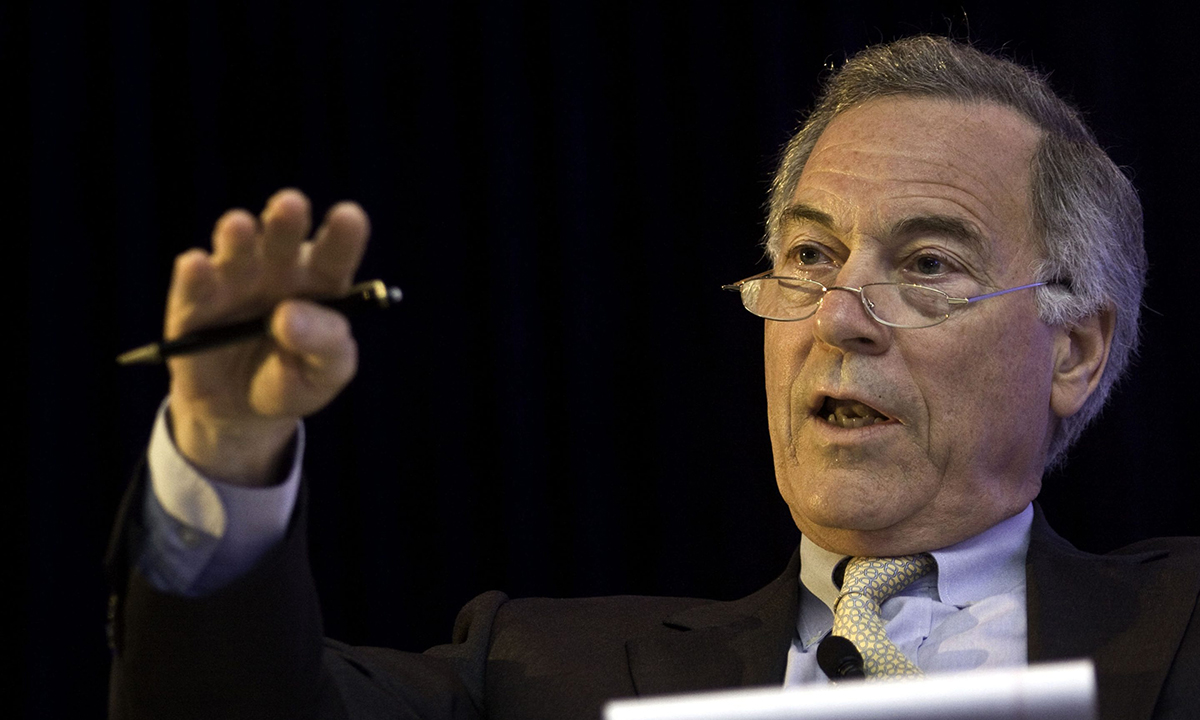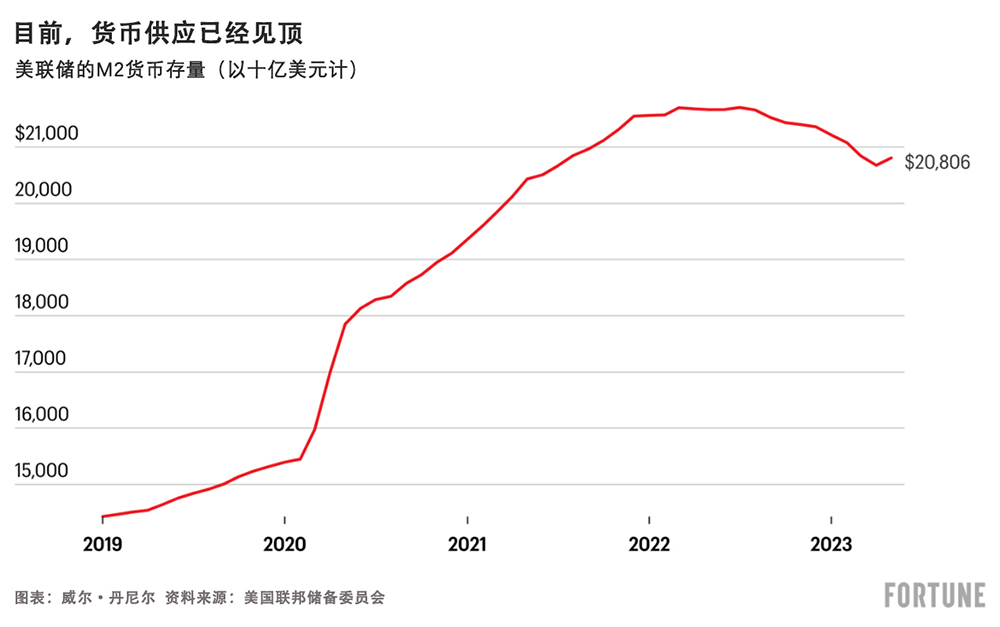
在2023年的大部分時(shí)間里,經(jīng)濟(jì)學(xué)家們一直在對(duì)粘性通脹發(fā)出警告。
如今,一位被稱(chēng)為“貨幣醫(yī)生”的著名學(xué)者對(duì)這一觀點(diǎn)提出了質(zhì)疑:“粘性”通貨膨脹可能讓美聯(lián)儲(chǔ)(Federal Reserve)在實(shí)現(xiàn)雙重目標(biāo)(確保價(jià)格穩(wěn)定和實(shí)現(xiàn)充分就業(yè))時(shí)面臨嚴(yán)峻挑戰(zhàn)。
“忘掉我們聽(tīng)到的所有宣傳吧,比如美聯(lián)儲(chǔ)主席面臨棘手問(wèn)題,這將是一場(chǎng)曠日持久的斗爭(zhēng),事情很棘手等等。其實(shí),事情并不是很棘手。”約翰斯·霍普金斯大學(xué)(Johns Hopkins University)的應(yīng)用經(jīng)濟(jì)學(xué)教授史蒂夫·漢克于7月13日對(duì)美國(guó)消費(fèi)者新聞與商業(yè)頻道(CNBC)表示:“我認(rèn)為通脹已經(jīng)成為歷史。”
成為貨幣醫(yī)生之路
漢克在過(guò)去的幾十年時(shí)間里為國(guó)家元首和財(cái)政部部長(zhǎng)提供經(jīng)濟(jì)政策建議,因此獲得了“貨幣醫(yī)生”的稱(chēng)號(hào)。20世紀(jì)80年代,他曾經(jīng)在美國(guó)總統(tǒng)羅納德·里根的經(jīng)濟(jì)顧問(wèn)委員會(huì)(Council of Economic Advisers)任職,并在20世紀(jì)90年代協(xié)助印度尼西亞總統(tǒng)蘇哈托應(yīng)對(duì)亞洲金融危機(jī)(Asian Financial Crisis)為該國(guó)帶來(lái)的影響。漢克目前正在為阿根廷的自由黨候選人哈維爾·米萊的助手提供建議(抗擊該國(guó)嚴(yán)重通脹的最佳方案)。
這位教授是貨幣主義的支持者(貨幣主義是一種經(jīng)濟(jì)理論,認(rèn)為貨幣供應(yīng)量的變化是通貨膨脹的主要驅(qū)動(dòng)因素)。由于過(guò)去一年美國(guó)的貨幣供應(yīng)不斷萎縮,漢克認(rèn)為通貨膨脹不再是問(wèn)題。這并不意味著消費(fèi)者價(jià)格會(huì)下降(那將造成通貨緊縮),但它確實(shí)標(biāo)志著租金、食品和能源價(jià)格飆升時(shí)代的終結(jié)。
漢克說(shuō):“事實(shí)上,美國(guó)的貨幣供應(yīng)量已經(jīng)同比萎縮了4%。自1938年以來(lái),我們從未見(jiàn)過(guò)這種情況。一切都與貨幣有關(guān),因此[通脹下降]數(shù)據(jù)并不令我感到意外。”
漢克在7月13日繼續(xù)指責(zé)媒體和他的經(jīng)濟(jì)學(xué)家同行們聚焦“通貨膨脹的非貨幣原因”,例如供應(yīng)鏈問(wèn)題或企業(yè)利潤(rùn)率上升。“這簡(jiǎn)直是一派胡言。”他表示,并稱(chēng)自己剛剛完成了一項(xiàng)研究,將于今年9月發(fā)表。該研究顯示,貨幣供應(yīng)量的變化與通脹的變化之間存在一一對(duì)應(yīng)的關(guān)系。
漢克指出,M2(廣義貨幣供應(yīng)量)指標(biāo)(美聯(lián)儲(chǔ)追蹤美國(guó)經(jīng)濟(jì)中的貨幣存量)在2020年2月新冠疫情開(kāi)始到去年3月達(dá)到峰值期間,飆升了40%以上。在此期間,同比通脹率從2.3%躍升至8.5%。
然后,從去年7月到今年5月,貨幣供應(yīng)量下降了近5%。年通脹率也隨之從8.5%降至4%。

來(lái)自批發(fā)價(jià)格方面的證據(jù)
漢克表示,如果美聯(lián)儲(chǔ)繼續(xù)縮減貨幣供應(yīng),通貨膨脹就將很快達(dá)到“2%的目標(biāo)范圍”,他指出,批發(fā)價(jià)格的下降就是他提出的理論的證據(jù)。美國(guó)勞工統(tǒng)計(jì)局(Bureau of Labor Statistics)在7月13日公布的數(shù)據(jù)顯示,6月衡量商品和服務(wù)生產(chǎn)商批發(fā)價(jià)格的生產(chǎn)者價(jià)格指數(shù)(PPI)僅較上年同期上漲0.1%,遠(yuǎn)低于2022年4月11.5%的峰值。
漢克稱(chēng),在2021年通脹上升時(shí),生產(chǎn)者價(jià)格指數(shù)領(lǐng)漲消費(fèi)者價(jià)格指數(shù)(CPI),而核心通脹(不包括波動(dòng)性較大的能源和食品價(jià)格)則落后于消費(fèi)者價(jià)格指數(shù)。“現(xiàn)在,我們已經(jīng)扭轉(zhuǎn)了局面,生產(chǎn)者價(jià)格指數(shù)直線下降……消費(fèi)者價(jià)格指數(shù)也直線下降。核心通脹已經(jīng)遠(yuǎn)遠(yuǎn)落后了。”他說(shuō),并指出如果美聯(lián)儲(chǔ)繼續(xù)縮減M2,“我們就將看到所有指數(shù)下降”。
漢克并不是唯一一位對(duì)通脹持樂(lè)觀看法的人。LPL Financial的首席經(jīng)濟(jì)學(xué)家杰弗里·羅奇告訴《財(cái)富》雜志,最新的生產(chǎn)者價(jià)格指數(shù)的數(shù)據(jù)“對(duì)迫切希望看到通脹消退的投資者來(lái)說(shuō)是另一個(gè)積極反饋”。
他補(bǔ)充道:“批發(fā)價(jià)格的下降,尤其是交通運(yùn)輸價(jià)格的下降,預(yù)示著在2023年的剩余時(shí)間里,經(jīng)濟(jì)活動(dòng)放緩,消費(fèi)價(jià)格進(jìn)一步下降。”
盡管經(jīng)濟(jì)學(xué)家對(duì)2023年年初的通脹預(yù)測(cè)差異很大,而且他們對(duì)經(jīng)濟(jì)衰退的預(yù)測(cè)在過(guò)去幾年中也差強(qiáng)人意,因此,關(guān)注漢克的理論可能是有意義的。今年2月,他預(yù)測(cè)通脹率將在2023年全年下降至2%至5%之間。隨后,漢克解釋道:“大約兩個(gè)月前,我接受了《財(cái)富》雜志肖恩·塔利的采訪,我說(shuō)我認(rèn)為通脹率可能會(huì)處于這個(gè)區(qū)間的下限范圍內(nèi)。現(xiàn)在看來(lái)確實(shí)如此。”
如果漢克的觀點(diǎn)是正確的,那么2023年美國(guó)經(jīng)濟(jì)面臨的真正問(wèn)題就將不再是通脹,而是如何實(shí)現(xiàn)增長(zhǎng)。(財(cái)富中文網(wǎng))
譯者:中慧言-王芳
在2023年的大部分時(shí)間里,經(jīng)濟(jì)學(xué)家們一直在對(duì)粘性通脹發(fā)出警告。
如今,一位被稱(chēng)為“貨幣醫(yī)生”的著名學(xué)者對(duì)這一觀點(diǎn)提出了質(zhì)疑:“粘性”通貨膨脹可能讓美聯(lián)儲(chǔ)(Federal Reserve)在實(shí)現(xiàn)雙重目標(biāo)(確保價(jià)格穩(wěn)定和實(shí)現(xiàn)充分就業(yè))時(shí)面臨嚴(yán)峻挑戰(zhàn)。
“忘掉我們聽(tīng)到的所有宣傳吧,比如美聯(lián)儲(chǔ)主席面臨棘手問(wèn)題,這將是一場(chǎng)曠日持久的斗爭(zhēng),事情很棘手等等。其實(shí),事情并不是很棘手。”約翰斯·霍普金斯大學(xué)(Johns Hopkins University)的應(yīng)用經(jīng)濟(jì)學(xué)教授史蒂夫·漢克于7月13日對(duì)美國(guó)消費(fèi)者新聞與商業(yè)頻道(CNBC)表示:“我認(rèn)為通脹已經(jīng)成為歷史。”
成為貨幣醫(yī)生之路
漢克在過(guò)去的幾十年時(shí)間里為國(guó)家元首和財(cái)政部部長(zhǎng)提供經(jīng)濟(jì)政策建議,因此獲得了“貨幣醫(yī)生”的稱(chēng)號(hào)。20世紀(jì)80年代,他曾經(jīng)在美國(guó)總統(tǒng)羅納德·里根的經(jīng)濟(jì)顧問(wèn)委員會(huì)(Council of Economic Advisers)任職,并在20世紀(jì)90年代協(xié)助印度尼西亞總統(tǒng)蘇哈托應(yīng)對(duì)亞洲金融危機(jī)(Asian Financial Crisis)為該國(guó)帶來(lái)的影響。漢克目前正在為阿根廷的自由黨候選人哈維爾·米萊的助手提供建議(抗擊該國(guó)嚴(yán)重通脹的最佳方案)。
這位教授是貨幣主義的支持者(貨幣主義是一種經(jīng)濟(jì)理論,認(rèn)為貨幣供應(yīng)量的變化是通貨膨脹的主要驅(qū)動(dòng)因素)。由于過(guò)去一年美國(guó)的貨幣供應(yīng)不斷萎縮,漢克認(rèn)為通貨膨脹不再是問(wèn)題。這并不意味著消費(fèi)者價(jià)格會(huì)下降(那將造成通貨緊縮),但它確實(shí)標(biāo)志著租金、食品和能源價(jià)格飆升時(shí)代的終結(jié)。
漢克說(shuō):“事實(shí)上,美國(guó)的貨幣供應(yīng)量已經(jīng)同比萎縮了4%。自1938年以來(lái),我們從未見(jiàn)過(guò)這種情況。一切都與貨幣有關(guān),因此[通脹下降]數(shù)據(jù)并不令我感到意外。”
漢克在7月13日繼續(xù)指責(zé)媒體和他的經(jīng)濟(jì)學(xué)家同行們聚焦“通貨膨脹的非貨幣原因”,例如供應(yīng)鏈問(wèn)題或企業(yè)利潤(rùn)率上升。“這簡(jiǎn)直是一派胡言。”他表示,并稱(chēng)自己剛剛完成了一項(xiàng)研究,將于今年9月發(fā)表。該研究顯示,貨幣供應(yīng)量的變化與通脹的變化之間存在一一對(duì)應(yīng)的關(guān)系。
漢克指出,M2(廣義貨幣供應(yīng)量)指標(biāo)(美聯(lián)儲(chǔ)追蹤美國(guó)經(jīng)濟(jì)中的貨幣存量)在2020年2月新冠疫情開(kāi)始到去年3月達(dá)到峰值期間,飆升了40%以上。在此期間,同比通脹率從2.3%躍升至8.5%。
然后,從去年7月到今年5月,貨幣供應(yīng)量下降了近5%。年通脹率也隨之從8.5%降至4%。
來(lái)自批發(fā)價(jià)格方面的證據(jù)
漢克表示,如果美聯(lián)儲(chǔ)繼續(xù)縮減貨幣供應(yīng),通貨膨脹就將很快達(dá)到“2%的目標(biāo)范圍”,他指出,批發(fā)價(jià)格的下降就是他提出的理論的證據(jù)。美國(guó)勞工統(tǒng)計(jì)局(Bureau of Labor Statistics)在7月13日公布的數(shù)據(jù)顯示,6月衡量商品和服務(wù)生產(chǎn)商批發(fā)價(jià)格的生產(chǎn)者價(jià)格指數(shù)(PPI)僅較上年同期上漲0.1%,遠(yuǎn)低于2022年4月11.5%的峰值。
漢克稱(chēng),在2021年通脹上升時(shí),生產(chǎn)者價(jià)格指數(shù)領(lǐng)漲消費(fèi)者價(jià)格指數(shù)(CPI),而核心通脹(不包括波動(dòng)性較大的能源和食品價(jià)格)則落后于消費(fèi)者價(jià)格指數(shù)。“現(xiàn)在,我們已經(jīng)扭轉(zhuǎn)了局面,生產(chǎn)者價(jià)格指數(shù)直線下降……消費(fèi)者價(jià)格指數(shù)也直線下降。核心通脹已經(jīng)遠(yuǎn)遠(yuǎn)落后了。”他說(shuō),并指出如果美聯(lián)儲(chǔ)繼續(xù)縮減M2,“我們就將看到所有指數(shù)下降”。
漢克并不是唯一一位對(duì)通脹持樂(lè)觀看法的人。LPL Financial的首席經(jīng)濟(jì)學(xué)家杰弗里·羅奇告訴《財(cái)富》雜志,最新的生產(chǎn)者價(jià)格指數(shù)的數(shù)據(jù)“對(duì)迫切希望看到通脹消退的投資者來(lái)說(shuō)是另一個(gè)積極反饋”。
他補(bǔ)充道:“批發(fā)價(jià)格的下降,尤其是交通運(yùn)輸價(jià)格的下降,預(yù)示著在2023年的剩余時(shí)間里,經(jīng)濟(jì)活動(dòng)放緩,消費(fèi)價(jià)格進(jìn)一步下降。”
盡管經(jīng)濟(jì)學(xué)家對(duì)2023年年初的通脹預(yù)測(cè)差異很大,而且他們對(duì)經(jīng)濟(jì)衰退的預(yù)測(cè)在過(guò)去幾年中也差強(qiáng)人意,因此,關(guān)注漢克的理論可能是有意義的。今年2月,他預(yù)測(cè)通脹率將在2023年全年下降至2%至5%之間。隨后,漢克解釋道:“大約兩個(gè)月前,我接受了《財(cái)富》雜志肖恩·塔利的采訪,我說(shuō)我認(rèn)為通脹率可能會(huì)處于這個(gè)區(qū)間的下限范圍內(nèi)。現(xiàn)在看來(lái)確實(shí)如此。”
如果漢克的觀點(diǎn)是正確的,那么2023年美國(guó)經(jīng)濟(jì)面臨的真正問(wèn)題就將不再是通脹,而是如何實(shí)現(xiàn)增長(zhǎng)。(財(cái)富中文網(wǎng))
譯者:中慧言-王芳
Economists have been chanting warnings of the sticky inflation theory for most of 2023.
Now, a notable scholar known as the “money doctor” is challenging the idea that “sticky” inflation could make the Federal Reserve’s job of ensuring price stability and maximum employment for Americans a serious challenge.
“Forget all the propaganda we’re hearing — that the chairman of the Federal Reserve has a tough problem, that this is going to be a long fight, things are sticky and so forth. Things aren’t sticky,” Steve Hanke, a professor of applied economics at Johns Hopkins University, told CNBC on July 13. “I think the inflation story is history.”
Becoming the money doctor
Hanke earned his “money doctor” moniker after spending decades advising heads of state and finance ministers on economic policy. He served on President Reagan’s Council of Economic Advisers in the 80’s, and helped Indonesian President Suharto tackle the fallout from the Asian Financial Crisis in the 90’s. He’s currently consulting with aides to the Argentinian libertarian party candidate Javier Milei on the best ways to combat the nation’s rampant inflation.
The professor is a proponent of monetarism, an economic theory that holds that changes in the money supply are the main driver of inflation. With the money supply in the U.S. contracting over the past year, he believes inflation is no longer an issue. That doesn’t mean consumer prices are set to fall (that would be deflation), but it does signal the end of the era of surging rent, food, and energy prices.
“The fact that the money supply has been contracting on a year-over-year basis by 4% in the United States. We haven’t seen that since 1938,” Hanke said. “It’s all about money, so the [falling inflation] numbers don’t surprise me.”
Hanke went on to rebuke the press and his economist peers for focusing on “non-monetary causes of inflation”—like supply chain issues or rising corporate profit margins—on July 13. “This is utter rubbish,” he said, noting that he just finished a study, set to be published in September, which shows a one-to-one relationship between changes in the money supply and changes in inflation.
To Hanke’s point, the Federal Reserve’s M2 measure, which tracks the money stock in the U.S. economy, surged over 40% between February 2020 when the pandemic began and its peak in March of last year. During that period, year-over-year inflation jumped from 2.3% to 8.5%.
Then, between last July and this May, the money supply dropped nearly 5%. And year-over-year inflation again followed suit, falling from 8.5% to just 4%.
Evidence from wholesale prices
If the Fed continues to shrink the money supply, Hanke said inflation will hit the “2% range pretty fast,” pointing to falling wholesale prices as evidence for his theory. The producer price index (PPI), which measures wholesale prices for goods and services producers, rose just 0.1% from a year ago in June, the Bureau of Labor Statistics reported on July 13. That’s down from a peak of 11.5% in April of 2022.
Hanke noted that in 2021, when inflation was rising, the producer price index led the consumer price index higher, while core inflation, which excludes volatile energy and food prices, lagged behind. “Now, we’ve turned the thing around and the producer price indexes are falling like a stone….The consumer price index, it’s falling pretty much like a stone. And the core is lagging way behind,” he said, noting that “we’ll see all of that come down” if the Fed keeps shrinking M2.
Hanke isn’t alone in his more positive view of inflation. Jeffrey Roach, chief economist at LPL Financial, told Fortune that the latest PPI data was “another positive report for investors desperate to see inflation dissipate.”
“The decline in wholesale prices, especially for transporting freight, foreshadows a slowdown in both economic activity and a further deceleration in consumer prices throughout the balance of 2023,” he added.
While economist’s inflation predictions varied widely at the start of 2023, and their track record forecasting recessions hasn’t been the best over the past few years, it may make sense to pay attention to Hanke. In February, he predicted inflation would fall throughout 2023 to a range between 2% and 5%. Then, Hanke explained: “About two months ago I did an interview in Fortune Magazine, with Shawn Tully, and I said I think it’ll probably be at the lower end of that range. And it’s looking like it will be.”
If Hanke is right, the real issue for the U.S. economy in 2023 won’t be inflation, it will be growth.






